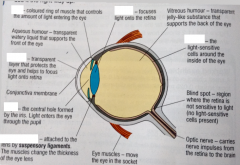![]()
![]()
![]()
Use LEFT and RIGHT arrow keys to navigate between flashcards;
Use UP and DOWN arrow keys to flip the card;
H to show hint;
A reads text to speech;
10 Cards in this Set
- Front
- Back
|
What is a converging (convex) lens?
|
A lens that makes parallel rays converge to a focus. The point they are focused to is the principal focus (or focal point) of the lens. We use converging lenses as magnifying glasses and in cameras to form clear images of distant objects.
|
|
|
What is a diverging (concave) lens?
|
A lens that makes parallel rays of light diverge. The point where the rays appear comes from the principle focus of the length. We use diverging lenses to correct short sight.
|
|
|
How does a camera lens produce an image?
|
A converging lens is used to produce a real image on film (or pixels for a digital camera). The position of the lens is adjusted to focus the image on the film.
|
|
|
How would you form a virtual image on each type of lens?
|
For a converging lens the object must be between the lens and its principle focus. The image is formed on the same side as the object. The image is virtual, upright, and larger than the object.
The image formed by a diverging lens is always virtual, upright, and smaller than the object. |
|
|
If the focal length is a negative value, what type of lens is it?
|
diverging (concave)
|
|

|

|
|
|
Compare the eye to a camera.
|
The focus of an eye lens is variable, unlike a fixed focus camera lens. To adjust the focus in an eye, the ciliary muscle alters the lens thickness but in a camera the position of the lens is adjusted. The image for both is real, inverted, and has a magnification of less than 1. Light sensitive cells on the retina detect the image but on a camera it is photographic film (or CCD sensors if it's digital). The iris controls the width of the eye pupil to control the brightness but you must adjust the aperture 'stop' on a camera.
|
|
|
In a short sighted and long sighted person, where is the uncorrected image formed and what lens must they use to fix it.
|
Short sighted - the uncorrected image forms in front of the retina and they must use a diverging lens to correct it.
Long sighted - the uncorrected image forms behind the retina and they must use a converging lens to correct it. |
|
|
What is the unit of power of a lens?
|
A dioptre (D) or m^-1. The type of lens is indicated by a positive value if it's converging and a negative value if it's diverging.
|
|
|
How do we make a more powerful lens (lower focal distance).
|
Use a material with a larger refractive index or a lens with a greater curvature of its surface. Manufacturing the lens flatter and thinner increases the refractive index since the lens surfaces would be less curved.
|

